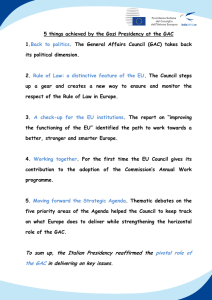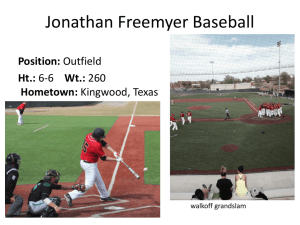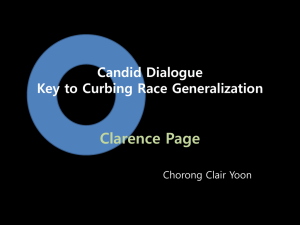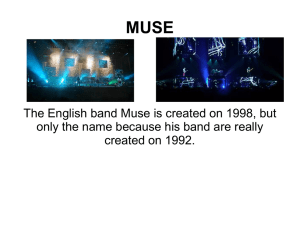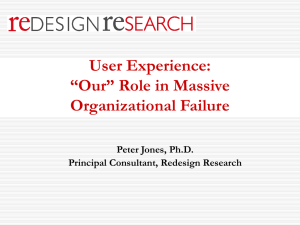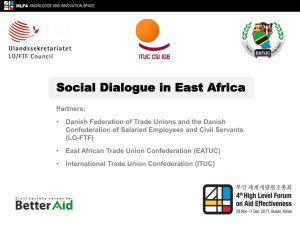Global Fund: Demystifying the New Funding Model
advertisement
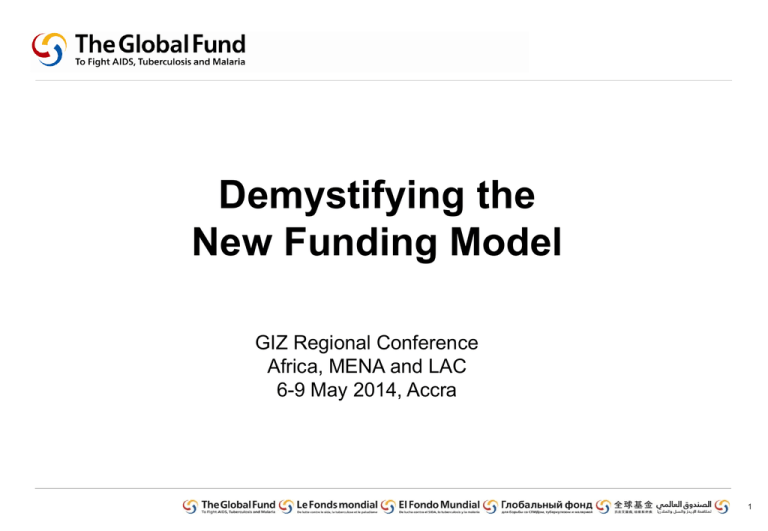
Demystifying the New Funding Model GIZ Regional Conference Africa, MENA and LAC 6-9 May 2014, Accra 1 Principles of the new funding model The new funding model has been designed to bring the Global Fund Strategy of ‘Investing for Impact’ to life. The new model will improve the way the Global Fund assesses, approves, disburses, and monitors grants Principles of the new funding model • Bigger impact: focus on countries with the highest disease burden and lowest ability to pay, while keeping the portfolio global • Predictable funding: process and financing levels become more predictable, with higher success rate of applications • Ambitious vision: ability to elicit full expressions of demand and reward ambition • Flexible timing: in line with country schedules, context, and priorities • More streamlined: for both implementers and the Global Fund 2 Overview of how funds are allocated to countries Allocation formula Qualitative factors Disease burden Grant performance Impact Income level Increasing infection rate External financing Absorptive capacity Minimum required level = Country allocation 15% of which accessible based on Willingness-to-Pay Risk 3 Counterpart Financing Core Global Fund principles: Sustainability, Additionality, Country Ownership Mandatory minimum requirements of counterpart financing ‘Willingness-to-Pay’ commitment to further incentivize • Minimum threshold contribution (LI5%, Lower LMI-20%, Upper LMI40%, UMI-60%) • Additional co-investments by government in disease programs in accordance with ability to pay • Increasing government contribution to disease programs and health sector • Realization of planned government commitments • Reliable disease and health expenditure data • 15% of allocation is contingent upon meeting WTP commitments 4 Allocation methodology Country band composition Band 4 Band 3 Higher-income, lower-burden Higher-income, higher-burden 55 countries 11 countries US$ 1.1bn US$ 1.5bn Income Band 4 countries have incentive funding calculated into their allocations Higher 0.26 composite score US$ 42 million of incentive funding available for Band 2 US$ 83 million of incentive funding available for Band 3 GNI per capita US$ 2,000 Band 2 Band 1 Lower-income, lower-burden Lower-income, higher-burden 18 countries 39 countries US$ 0.9 bn US$ 11.3 bn Lower 2 Lower Disease Burden US$ 825 million of incentive funding available for Band 1 Higher 55 Total funding from Global Fund is increasing • The total funds for allocation are 20% higher than what we have disbursed in the past. - The total funds to be allocated to countries, available as of January 1, 2014 (including existing funds): US$ 14.8 billion - Average implied funding level: US$ 3.7 billion per year - This compares favorably vs. the average annual disbursement rates of US$ 3.2 billion. • In addition, the Global Fund will allocate: - US$ 950 million of incentive funding which will be awarded to ambitious programs that deliver impact in country - US$ 200 million for new regional grants and US$ 91 million to finish existing regional grants This represents US$ 16 billion for countries 6 Types of funding Country allocation Incentive funding* Unfunded quality demand • Each eligible country receives an allocation to support its disease programs for the allocation period (communicated in March 2014) • The amount is determined using an allocation methodology based on disease burden and income levels, and is adjusted for qualitative factors • A separate reserve of funding designed to reward high impact, well-performing programs and encourage ambitious requests • It is made available, on a competitive basis, to applicants in Country Bands 1, 2, 3 • Awarding of incentive funding will be based on the TRP recommendation. The GAC will decide on incentive funding, which will be included in the upper-ceiling of the grant • Any funding requested through a concept note which is considered strategically focused and technically sound by the TRP, but cannot be funded through available funding • The demand is registered for possible funding by the Global Fund or other donors when, and if, any new resources become available * Regional applicants, significantly over-allocated disease components and Band 4 countries are not eligible for incentive funding. 7 New funding model cycle Ongoing Country Dialogue 2nd GAC TRP National Strategic Plan/ Investment Case Concept Note Grant Implementation Grant Making GAC Board 8 Country dialogue is a country-owned, on-going process Country Dialogue The term is used by the Global Fund to refer to the ongoing discussion that occurs at country level to prioritize how to fight the three diseases and strengthen health and community systems Country owned process Ongoing Country Dialogue Govt-led National Strategic Plan determined by country CCM-led Concept Note PR-led CCM/PR-led Grant-Making Grant Implementation 3 years 9 Who plays a role in country dialogue? Academia Country government Other donors Global Fund Private sector Country dialogue Technical partners Civil society / key populations These actors meet in the CCM, however, the dialogue should expand beyond the CCM 10 How do we engage with communities, including key populations? Encourage assembling of communities in advance of national meetings • Ensure they can raise their concerns on human rights, gender, access and other issues in a safe space without repercussions • Ensure confidentiality for all participants • Convene different groups of women, youth, key populations etc. separately and collectively as needed. Collective assembling can help create coalitions, separate meetings help in-depth discussions on specific needs and issues Facilitate meaningful participation e.g., national / regional meetings held outside the capital and in the local language Ensure communities understand what support they can expect from The Global Fund to address human rights, CSS, gender inequalities Ensure concerns raised by communities get raised and addressed during the country dialogue through lead representatives 11 Technical Assistance framework under the new funding model CCM strengthening HSS strengthening CS/KAPs strengthening and engagement Operational support (existing and new programs) 2nd GAC TRP National Strategic Plan/ Investment Case Situation analysis/epidemic assessment • Epidemiological analysis • Program gap • Financial gap • Capacity gap Strategic plans /Investment case development, reviews and costing Health Sector strategy Policy advice/enabling environment Concept Note 2-3 months Grant Making 3+months Board GAC Support to develop CN and all documentation • Use of modular tool • Program design • Selection of interventions • Indicative/above indicative budget CN review based on early feedback from TRP Risk and capacity assessment response and implementation capacity • Financial management • M&E • PSM • PR/SR/SSR management • Governance Start-up TA • GF systems/tools • Org development Disease-specific/public health technical support Grant Implementation 3 years Addressing implementation bottlenecks Long-term capacity development • M&E • Financial management • PSM • PR/SR/SSR management • Governance Disease-specific /public health technical support Partners mapping 12 What is the Technical Review Panel looking for? Soundness of approach Value for money Feasibility Criteria for reviewing funding requests Potential for sustainable outcomes 13 Resources available http://www.theglobalfund.org/en/fundingmodel/ Resource 1 New funding model Resource Book 2 Frequently Asked Questions about the new funding model 3 Online learning materials on key topics (e-learning modules) 4 Concept note templates and guidelines 5 Information notes 14 Useful links Further information about the New Funding Model can be found on the Global Fund website The following documents are available to support the countries during the application process: Overview of the Allocation Methodology (2014-2016) Resource Book for Applicants New Funding Model Brochure Frequently Asked Questions on the New Funding Model Frequently Asked Questions – Allocation Amounts Ten Frequently Asked Questions on the Global Fund Board Decision of a Single Concept Note Submission for Joint HIV and TB Programming Additional Applicant Support 15 ENTRY POINTS: NFM PROCESSES - Support to development of quality NSP and Investment Cases, gap analyis, etc. - Participation in/support to inclusive country dialogue/multistakeholder processes (including SWAP and Donor Groups) - Support to Concept Note develop-ment based on robust national strategies; - Integration in national systems - Dialogue with BMZ/ PROFILE for GAC inputs (based on GAC and TRP documents and specific issues discussed at country level) - Creation of robust implementation frameworks - Dialogue with BMZ/ PROFILE for GAC inputs and comments on funding recommendat ions - Capacity development for PRs, SRs on financial management, procurement, M&E, etc. - Support to risk management - TC measures complementary to GF grants - Support to local organizations in their role as implementer (CS and public organisations) Support to CCM Processes (to improve coordination, communication, oversight and risk management) Page 16
